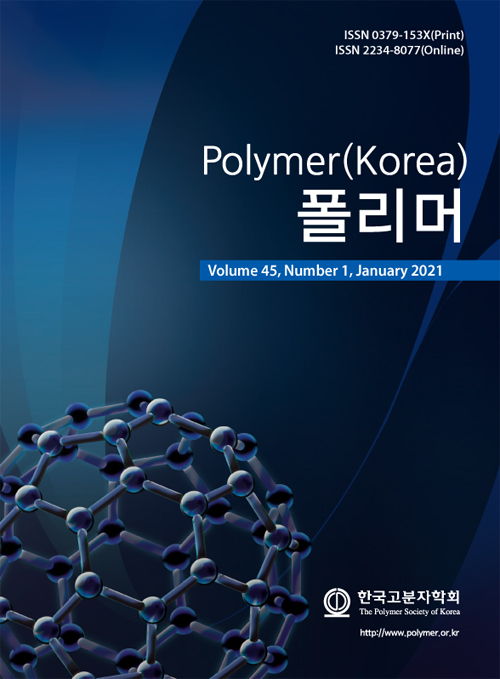- Investigation of Photovoltaic Properties of Polymer Solar Cells with Fluorene-based Polyelectrolytes as the Interlayer
Junho Lee# , Sabrina Aufar Salma# , Mijin Jeong, and Joo Hyun Kim†

Department of Polymer Engineering, Pukyong National University, 45 Yongso-ro, Nam-gu, Busan 48513, Korea
- Fluorene을 기본골격으로 한 공액형 고분자 전해질을 Interlayer로 적용한 고분자태양전지의 광전효과
부경대학교 고분자공학과
A series of conjugated polyelectrolytes (CPEs) based on fluorene named 6,6'-(2-phenyl-9H-fluorene-9,9-diyl)bis(N,N,N-trimethylhexan-1-aminium) bromide (PFB-Br), 6,6'-(2-(thiophene-2-yl)-9H-fluorene-9,9-diyl)bis(N,N,N-trimethylhexan-1-aminium) bromide (PFT-Br), and 6,6'-(2-([2,2'-bithiophen]-5-yl)-9H-fluorene-9,9-diyl)bis(N,N,N-trimethylhexan-1-aminium) bromide (PF2T-Br) were synthesized and applied as the interlayer to investigate how the backbone structure influence the photovoltaic properties. The ionic functionality of CPE accumulates on the ZnO surface, owing to the existing interactions between the ionic groups and the ZnO. The CPE backbone is shifted toward the ZnO surface. Thus, there is a formation of interface dipole via the re-organization of the ionic side chains and hydrophobic backbone. However, incorporation of the electron-rich moiety, thiophene, or bithiophene, in the polymer backbone interfere with the electron transport at the cathode interface. As a result, the power conversion efficiency (PCE) of polymer with thiophene and bithiophene backbone structure was decreased compare with PFB-Br, which has electron-affinity property than PFT-Br, and PF2T-Br.
고분자의 주사슬 구조가 광전 특성에 어떠한 영향을 미치는지에 관하여 조사하기 위해 고분자 전해질, 6,6'-(2-phenyl-9H-fluorene-9,9-diyl)bis(N,N,N-trimethylhexan-1-aminium) bromide(PFB-Br), 6,6'-(2-(thiophen-2-yl)-9H-fluorene-9,9-diyl)bis(N,N,N-trimethylhexan-1-aminium) bromide(PFT-Br), 6,6'-(2-([2,2'-bithiophen]-5-yl)-9H-fluorene-9,9-diyl)bis(N,N,N-trimethylhexan-1-aminium) bromide(PF2T-Br)을 합성하여 유기 태양광 소자의 중간층으로 도입하였다. 이온성 곁사슬은 스핀 코팅 과정 도중에 ZnO와 상호 작용으로 인해 ZnO 표면으로 자발적으로 배향되며, 주사슬은 반대 방향으로 재배열된다. 고분자 전해질의 재배열로 인해 소자에서 일정한 배향을 가지는 영구 쌍극자가 형성됨으로써, 추가적인 내부 자기장이 형성된다. 주사슬에 도입된 벤젠에 비해 높은 전자 밀도를 가지는 thiophene과 bithiophene에 의해 서로 다른 전자친화도를 가지게 되어 PFT-Br, PF2T-Br의 전자 전달이 방해되고 PFB-Br에 비하여 더 낮은 전력 변환 효율을 나타냄을 확인하였다.
Keywords: polymer solar cell, fluorene-based polyelectrolyte, thiophene, cathode interlayer
- Polymer(Korea) 폴리머
- Frequency : Bimonthly(odd)
ISSN 0379-153X(Print)
ISSN 2234-8077(Online)
Abbr. Polym. Korea - 2023 Impact Factor : 0.4
- Indexed in SCIE
 This Article
This Article
-
2021; 45(1): 134-142
Published online Jan 25, 2021
- 10.7317/pk.2021.45.1.134
- Received on Sep 10, 2020
- Revised on Sep 28, 2020
- Accepted on Oct 9, 2020
 Correspondence to
Correspondence to
- Joo Hyun Kim
-
Department of Polymer Engineering, Pukyong National University, 45 Yongso-ro, Nam-gu, Busan 48513, Korea
- E-mail: jkim@pknu.ac.kr









 Copyright(c) The Polymer Society of Korea. All right reserved.
Copyright(c) The Polymer Society of Korea. All right reserved.